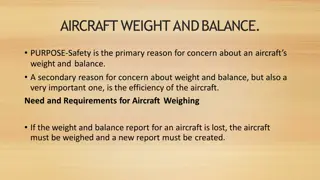Aircraft Manoeuvrability and Control Principles
Explore the principles governing the stability and manoeuvrability of aircraft, focusing on how control surfaces like elevators, ailerons, and rudders influence pitching, rolling, and yawing movements. Discover the significance of trimming devices and primary flying controls in maintaining flight stability.
Uploaded on Aug 25, 2024 | 1 Views
Download Presentation

Please find below an Image/Link to download the presentation.
The content on the website is provided AS IS for your information and personal use only. It may not be sold, licensed, or shared on other websites without obtaining consent from the author.If you encounter any issues during the download, it is possible that the publisher has removed the file from their server.
You are allowed to download the files provided on this website for personal or commercial use, subject to the condition that they are used lawfully. All files are the property of their respective owners.
The content on the website is provided AS IS for your information and personal use only. It may not be sold, licensed, or shared on other websites without obtaining consent from the author.
E N D
Presentation Transcript
Uncontrolled copy not subject to amendment Principles of Flight Learning Outcome 2 Understand how the stability and manoeuvrability of an aeroplane are controlled Part 4: describe how aircraft and controls can be used for manoeuvrability Revision 2.00
Principles of Flight Revision
1. What are the 3 planes of an aircrafts movement? a. Pitching, lateral and rolling b. Pitching, rolling and yawing c. Yawing, longitudinal and rolling d. Longitudinal, lateral and normal
2. Which one of the following will REDUCE lateral stability? a. Dihedral b. A large fin c. Sweepback d. Anhedral
3. What are the 3 axes about which an aircraft can move? a. Pitching, lateral and longitudinal b. Pitching, rolling and yawing c. Yawing, longitudinal and normal d. Longitudinal, lateral and normal
4. Which three terms describe static stability? a. Stable, neutral and unstable b. Stable, rolling and unstable c. Yawing, neutral and stable d. Neutral, unstable and pitching
Primary flying controls and trimming devices Objectives: List the pilot s primary flying controls Describe pitching, rolling and yawing movements Understand how pitching, yawing and rolling are all related to the pilot Identify and state the purpose of trimming tabs Describe how trimming devices work Explain the use of elevators, ailerons and rudder
Flying controls We know how an aircraft flies, but how do we control it?
There are three primary flying controls: Pitch Nose up/down Elevators Roll Wings one up/one down Ailerons Yaw Nose left/right Rudder ALL control inputs are relative to the pilot regardless of the aircraft s attitude or position
Elevators Rudder Ailerons
Elevators Longitudinal control affecting pitch Flight path
Ailerons Lateral control affecting roll
Rudder Directional control affecting yaw Flight path
Trimming We are flying straight and level, but something changes ..... We have: Increased or decreased speed Used our fuel Dropped bombs Fired our guns (Eaten all of the rations!)
The aircraft is now out of balance and we may be holding a stick force to fly This will be tiring and prevent the pilot from carrying out other tasks such as navigation What can we do? Trim the aircraft
+ + + + + Pull force Stick force remains
Larger moment arm + + + + + + Pull force Stick force remains Stick force removed
To control column Fixed tab
Fixed tabs To reduce the pilot s physical workload
Trim Tabs To trim wheel To control column Trim tab Can be adjusted in the air
Aerodynamic balancing Geared tab
Trim Tabs Remember - Trim tabs work in the natural sense i.e. If you are pulling back on the control column to control the aircraft, then you trim back on the trimmer
1. Which surfaces control an aircraft in the rolling plane? a. Elevators b. Ailerons c. Rudder d. Tabs
We pitch an aircraft by using the: a. Elevators b. Ailerons c. Rudder d. Tabs
3. What may cause an imbalance in roll? a. Uneven tyre pressures b. Rudder not central c. Wing fuel imbalance d. A heavy co-pilot!
4. On an aircraft with two wing mounted engines, which control would be used to keep the aircraft straight if one engine failed? a. Elevators b. Ailerons c. Rudder d. Tabs























